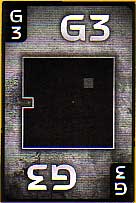| x | |||||||||||||||||||||||||||||||||||||||||||||||||||||||||||||
 |
|||||||||||||||||||||||||||||||||||||||||||||||||||||||||||||
| xx | |||||||||||||||||||||||||||||||||||||||||||||||||||||||||||||
| To relieve the overcrowded London, in the sixties the British government decided to establish a new city in the South East of England. This city would be named Milton Keynes, after one of the nineteen sleepy pictoresque villages lying in the planned area. It must have been the wet dream of every planner to assist in this development, to work on grid lines one mile apart. Terms such as grid roads, and names as grid squares for the districts indicate how the plan was carried out. Modernistic novelties such as roundabouts frequently were used in the road plan. Whether it has produced a livable city is not in the records of wikipedia, but what we do know now is the setting of the game and what we’ll have to do: straightforward building, and this for as much as possible playing money, although in the real Milton Keynes hard cash or bank money, but above all prestige will have been at stake. | |||||||||||||||||||||||||||||||||||||||||||||||||||||||||||||
| x | |||||||||||||||||||||||||||||||||||||||||||||||||||||||||||||
|
The map board shows a grid from A1 to J9 against a green background; at the edge is an income track with some roundabouts en route; all players start at the lowest position ‘10’. This track is consulted at the beginning of each round to see how much money each player receives. Players start the game with a bonus of 20 and thus with 30 money. With this they buy deeds -plots such as H8 or F3- and acquire permits to build specific buildings. Small blue discs representing a river are put on specific positions on the board, as well as two large swamp tiles that also are placed on fixed positions. |
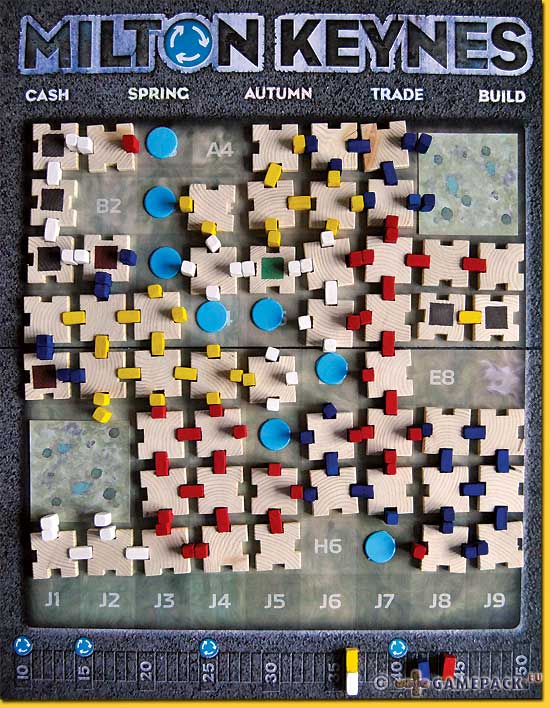 |
||||||||||||||||||||||||||||||||||||||||||||||||||||||||||||
| x | |||||||||||||||||||||||||||||||||||||||||||||||||||||||||||||
 |
Before the start of the game players choose a character, each character coming with a set of different permits. The character can be immediately forgotten as they are only used for the initial hand out of permits. With these permits, players have something in their hands with which to build, and through the different sets of permits they also have different interests. The players also start with three deed cards. | ||||||||||||||||||||||||||||||||||||||||||||||||||||||||||||
| x | |||||||||||||||||||||||||||||||||||||||||||||||||||||||||||||
| Each round as many deed cards are turned face up as participating players. After this there is a blind bidding; all bids go to the bank and the highest bid is the first to buy one of the deed cards for five money; other players follow in rank of their bids. Such an auction is held twice per round. | 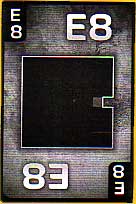 |
||||||||||||||||||||||||||||||||||||||||||||||||||||||||||||
| x | |||||||||||||||||||||||||||||||||||||||||||||||||||||||||||||
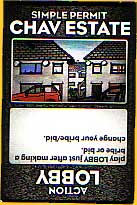 |
What follows is the trade phase in which players may trade; exchange or sell their deeds, but more important in this phase is the acquisition of building permits. Between each player a building permit -from a blind stack of permits- is placed. All players make two bids, they take one in each hand, and hold it left and right above the two permits. This way each permit has two bids. The highest bid wins, and gives the bid to the losing player, who takes this money and also takes his own bid back. In this way a player has two chances to acquire a permit, and these permits are, together with one or more deeds, necessary to be able to build. | ||||||||||||||||||||||||||||||||||||||||||||||||||||||||||||
| x | |||||||||||||||||||||||||||||||||||||||||||||||||||||||||||||
| A player may build up to two buildings each round, that may extend over several lots. Each deed or chain of deeds must be accompanied by a building permit. When building, a player places a wooden building block in his colour at the sides of his building; when it’s an internal wall -two adjacent tiles of the same building- one lying block is placed; when it’s adjacent to another building one standing block is placed. When the building is at least two tiles larger than the adjacent building, two building blocks are placed: one at the own player’s tile, and one at the neighbour’s. | |||||||||||||||||||||||||||||||||||||||||||||||||||||||||||||
| x | |||||||||||||||||||||||||||||||||||||||||||||||||||||||||||||
| Buildings bordering to rivers get an extra building block at each side adjacent to that river; in contrast a building adjacent to a swamp only earns building blocks for its internal walls or other buildings but not for sides that are adjacent to the swamp. Each income block earns a player income; ten is added and the result is added to the income track that at the beginning of the next round is paid out. | 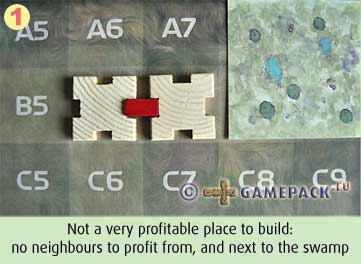 |
||||||||||||||||||||||||||||||||||||||||||||||||||||||||||||
| x | |||||||||||||||||||||||||||||||||||||||||||||||||||||||||||||
 |
Some permits are more wanted than others as they are more lucrative. Normally, it is not possible to extend an existing building, but with the building permit ‘extension’ this is allowed. With this permit and one or more adjacent deeds it is possible to grow even larger than the neighbour causing more income blocks to be placed and thus income to be collected. The permit ‘sewage processor’ makes expanding over the river possible, possibly connecting two buildings of the active player, also causing a shift in income blocks. | ||||||||||||||||||||||||||||||||||||||||||||||||||||||||||||
| x | |||||||||||||||||||||||||||||||||||||||||||||||||||||||||||||
| The permit ‘pikey camp’ provides the builder of the trailer park extra income blocks as he may place two blocks in almost every adjacent building and the same goes for the garbage dump permit, which does not produce income blocks for the neighbours but do allow this for the builder -at least when the building is larger. These are just some examples of permits that have effect on other buildings, but there are a few more. | 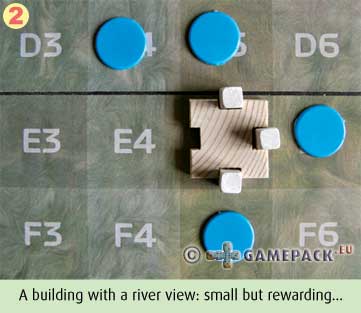 |
||||||||||||||||||||||||||||||||||||||||||||||||||||||||||||
| x | |||||||||||||||||||||||||||||||||||||||||||||||||||||||||||||
 |
After the building phase a new round begins with the collection of income according to the income track. This track has some roundabout fields; when a player reaches or passes it he immediately collects five money; when a player has to adjust his income because he had to take away income blocks from his buildings through another player’s action such as ‘demolish’ -taking away one complete building tile- he never falls below the roundabout field. The game continues until the stack of deeds is depleted; winner is the one with the largest number of income blocks on the board. |
||||||||||||||||||||||||||||||||||||||||||||||||||||||||||||
| x | |||||||||||||||||||||||||||||||||||||||||||||||||||||||||||||
| x | |||||||||||||||||||||||||||||||||||||||||||||||||||||||||||||
| x | |||||||||||||||||||||||||||||||||||||||||||||||||||||||||||||
| Nobody could have guessed that ‘Milton Keynes’ is the name of the game that has ‘APPROVED’ in billboard size on the box. One could think of it as a nice gimmick to give the game an architect like look, put it in a white card board (construction) box and add all sorts of graphical nonsense to it such as barcode, QR code, KIX code and a few other oddities, but it does not make it clearer what it all is about. Add to this the totally insane publisher name and one has a guaranteed recipe where the game, set in a display situation, ingloriously will gather dust until the end of times. | |||||||||||||||||||||||||||||||||||||||||||||||||||||||||||||
| x | |||||||||||||||||||||||||||||||||||||||||||||||||||||||||||||
| The game clearly is a well-intentioned do-it-yourself production: the map board is of hardboard and a bit heavy, but at least it can not break; the wood components are hand cut but not polished and hand painted and the money is designed and intended to represent bribing money: terms like stuffed envelopes and heavy briefcases should give the game a certain twist and atmosphere but this is unnecessery ballast, it’s just money in the denominations 1 and 5. But this money is so small, thin, printed on one side and overall so clumsy to play with that quick substitution from other games and their play money was sought. | 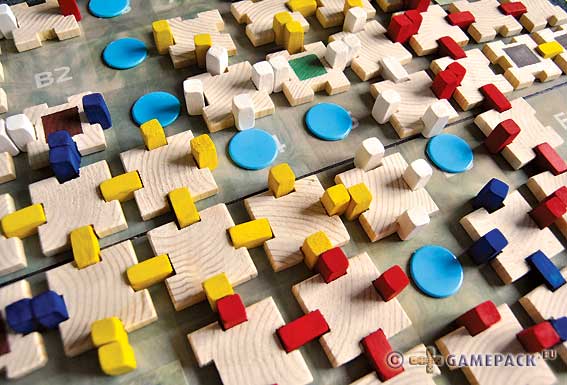 |
||||||||||||||||||||||||||||||||||||||||||||||||||||||||||||
| x | |||||||||||||||||||||||||||||||||||||||||||||||||||||||||||||
| The building plans -the deeds and the permits- must be put in a tiny envelope before all players reveal their plans, this also is terribly inconvenient and totally unnecessary. What is sorely missed is a player screen for the money because its absence makes the two blind and secret bids, one in each hand, almost impossible. No, there is much wrong with the execution of the game. But what about gameplay? | |||||||||||||||||||||||||||||||||||||||||||||||||||||||||||||
| x | x | ||||||||||||||||||||||||||||||||||||||||||||||||||||||||||||
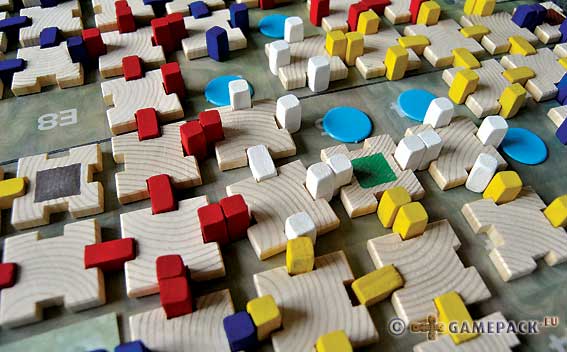 |
The rules state that it can be played with two players. But they are soon in trouble as the amount of income blocks is insufficient for all the buildings built. The author admits that the game should actually be played from 3 players and will change this in a future edition. | ||||||||||||||||||||||||||||||||||||||||||||||||||||||||||||
| x | |||||||||||||||||||||||||||||||||||||||||||||||||||||||||||||
| The rules talk about ‘bribe’ and ‘stab in the back’, but there really is not much of it in the game; the atmosphere is competitive but in a relaxed manner -all players do their own thing, most of the time. And that thing is actually rather abstract: players try to build large buildings giving the most revenues. The permits give the game a bit more flavor as this could not only have a positive effect for the owning player building somewhere, but also a negative effect for players who have buildings adjacent to such a building. In fact this is the indispensable spread on the basis sandwich. For building chains: this can also be done in ‘Acquire -and the game is unsurpassed in it. Building various buildings, preferably next to a river, is basically the same as building adjacent to the tram line in ‘Big City’ -and again there is a better -though not simpler- game that can be played. |
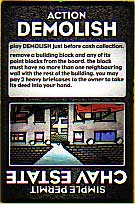 |
||||||||||||||||||||||||||||||||||||||||||||||||||||||||||||
| x | |||||||||||||||||||||||||||||||||||||||||||||||||||||||||||||
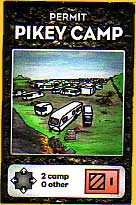 |
The manner in which income is collected is a nice find through which attractive permits cause high bids. But basically a player must try to collect a permit and a deed each turn and build in that round in order to increase the number of income blocks and income, through which new bids can be made. | ||||||||||||||||||||||||||||||||||||||||||||||||||||||||||||
| x | |||||||||||||||||||||||||||||||||||||||||||||||||||||||||||||
| It may seem a bit unfair to compare ‘Milton Keynes’ with two giants, as basically it is not a poor game, only: there is not the feeling playing something revolutionary. Although this is not an uncommon feeling, even with games from established publishers, but these games usually are better executed. In case of a rather abstract game such as ‘Milton Keynes’, it is simply not surprising or distinctive enough when, put to the choice, there will be a preference to play something else. © 2012 Richard van Vugt Milton Keynes, Gavin Wood, ÀÏ'ñ*, 2011 - 2 to 4 players, 14 years and up, 90-120 minutes |
|||||||||||||||||||||||||||||||||||||||||||||||||||||||||||||
| A somewhat chaotic building game that despite some original finds does not really impress | |||||||||||||||||||||||||||||||||||||||||||||||||||||||||||||
| x | |||||||||||||||||||||||||||||||||||||||||||||||||||||||||||||
| x | |||||||||||||||||||||||||||||||||||||||||||||||||||||||||||||
| x | |||||||||||||||||||||||||||||||||||||||||||||||||||||||||||||
